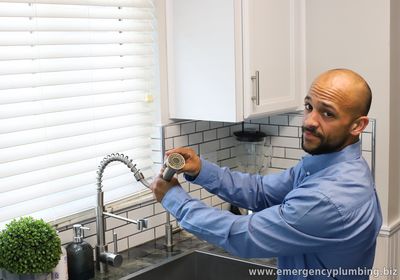10:29 PM How to Clean the Faucet Screen | |
"Low Water Pressure? Sediment in Your Faucet Screen Might Be the Culprit!"
Is your once-powerful faucet stream now reduced to a feeble trickle? Low water pressure can be a frustrating issue, but before you call in a plumber, consider a simple yet common culprit: sediment buildup in your faucet screen.
**What is Faucet Screen Sediment?**
Over time, tiny mineral particles, rust, and debris can accumulate in the aerator, which is the small screen located at the tip of your faucet. This sediment restricts the flow of water and leads to reduced water pressure. Thankfully, solving this problem is relatively easy and doesn't require professional assistance. **How to Check for Sediment Buildup:**
1. **Turn Off the Water:** Before you begin, turn off the water supply to the affected faucet. Look for shut-off valves under the sink. 2. **Remove the Aerator:** Gently unscrew the aerator from the tip of the faucet. If it's tightly attached, you may need pliers or a wrench, but be careful not to damage it. 3. **Inspect the Screen:** Once you've removed the aerator, inspect the screen for sediment buildup. You'll likely see tiny particles or debris blocking the holes.
**How to Clean the Faucet Screen:**
1. **Soak in Vinegar:** The most common method to clean the screen is to soak it in white vinegar. Fill a bowl with vinegar and let the aerator sit in it for about an hour. Vinegar helps dissolve mineral deposits. 2. **Scrub if Necessary:** For stubborn buildup, you can gently scrub the screen with an old toothbrush or a small brush. Be careful not to damage the screen. 3. **Rinse and Reattach:** After soaking and cleaning, rinse the aerator thoroughly with water to remove any remaining vinegar or debris. Then, reattach it to the faucet. 4. **Test the Water Pressure:** Turn on the water supply and check if the water pressure has improved. You should notice a significant difference in the flow.
**Preventing Future Sediment Buildup:** To avoid recurrent sediment buildup, consider using a water softener or a whole-house water filtration system. These systems can help reduce the minerals and debris that accumulate in your plumbing fixtures. By regularly checking and cleaning your faucet screens, you can maintain optimal water pressure and extend the life of your plumbing fixtures.
Don't let sediment buildup slow you down. Check and clean your faucet screens today.
| |
⏰ Dispatcher support 24/7
📞 224-754-1984CALL ☎ Subscribe 👆 FORUM 🗣
North Shore, Northwest suburbs of Chicago, IL
Next & Previous posts
| Total comments: 0 | |


